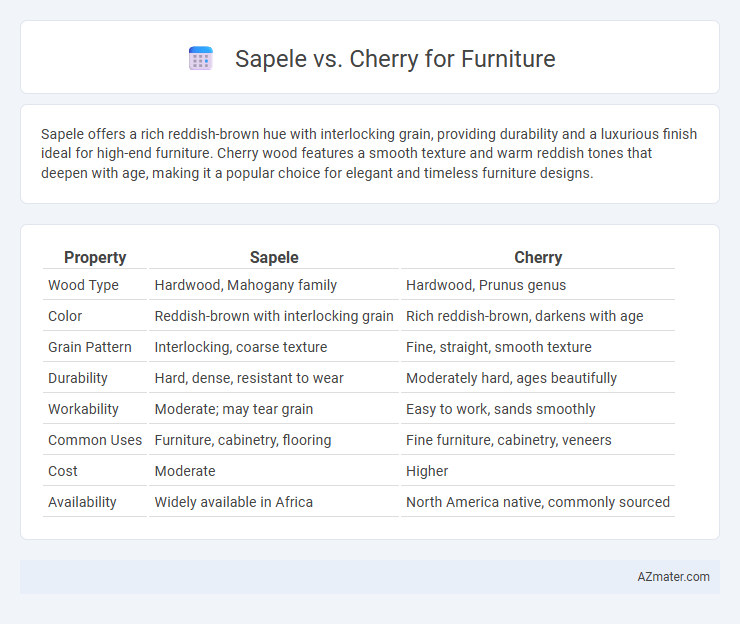Sapele offers a rich reddish-brown hue with interlocking grain, providing durability and a luxurious finish ideal for high-end furniture. Cherry wood features a smooth texture and warm reddish tones that deepen with age, making it a popular choice for elegant and timeless furniture designs.
Table of Comparison
| Property | Sapele | Cherry |
|---|---|---|
| Wood Type | Hardwood, Mahogany family | Hardwood, Prunus genus |
| Color | Reddish-brown with interlocking grain | Rich reddish-brown, darkens with age |
| Grain Pattern | Interlocking, coarse texture | Fine, straight, smooth texture |
| Durability | Hard, dense, resistant to wear | Moderately hard, ages beautifully |
| Workability | Moderate; may tear grain | Easy to work, sands smoothly |
| Common Uses | Furniture, cabinetry, flooring | Fine furniture, cabinetry, veneers |
| Cost | Moderate | Higher |
| Availability | Widely available in Africa | North America native, commonly sourced |
Introduction: Sapele vs Cherry Wood for Furniture
Sapele wood, a member of the Mahogany family, offers a rich reddish-brown hue and exceptional durability, making it a popular choice for high-end furniture. Cherry wood, prized for its smooth grain and warm, reddish tones that deepen over time, provides a classic aesthetic favored in traditional and contemporary designs. Both woods exhibit excellent workability and finish, but Sapele's higher density delivers greater resistance to wear compared to Cherry's softer texture.
Botanical Origins and Wood Characteristics
Sapele (Entandrophragma cylindricum) hails from West African tropical forests, featuring a reddish-brown hue with interlocking grain that produces a distinctive ribbon-like figure, known for its durability and resistance to wear. Cherry (Prunus serotina), native to North America, offers a warm, rich reddish-brown color that deepens with age, characterized by a fine, straight grain and smooth texture ideal for fine furniture and cabinetry. Both woods are prized for their workability and finish quality, but Sapele's density and interlocked grain make it more resistant to denting, while Cherry's vibrant patina and ease of carving favor decorative woodworking.
Color and Appearance: Sapele vs Cherry
Sapele exhibits a rich, reddish-brown hue with deep, interlocking grain patterns that create a striking, exotic appearance, often darkening over time to enhance its luxurious look. Cherry wood starts with a light pinkish tone that matures into a warm, rich reddish-brown, developing a smooth and uniform grain with a natural luster, giving furniture a classic and elegant aesthetic. Both woods offer distinctive colors and grains, but Sapele's bold, dramatic patterns contrast with Cherry's subtle, refined beauty, influencing the overall visual impact of furniture pieces.
Workability and Ease of Machining
Sapele wood offers excellent workability with a fine, even texture and interlocking grain that responds well to hand and machine tools, reducing the risk of tear-out during machining. Cherry wood is prized for its smooth grain and ease of shaping, sanding, and carving, making it a preferred choice for detailed furniture pieces and fine joinery. Both woods machine effectively, but Cherry tends to produce a cleaner finish and requires less effort when planing or routing compared to the denser, more interlocked grain of Sapele.
Durability and Strength Comparison
Sapele wood offers high durability and strength with a Janka hardness rating of approximately 1,410, making it resistant to dents and wear, ideal for sturdy furniture pieces. Cherry wood, with a Janka hardness of around 995, is comparatively softer but still strong and durable, favored for its smooth texture and ability to develop a rich patina over time. While Sapele excels in hardness and resistance to impact, Cherry provides adequate strength combined with excellent workability for detailed craftsmanship in furniture making.
Finishing Qualities and Surface Texture
Sapele wood offers a smooth, consistent surface texture with a natural sheen that enhances its finishing qualities, making it ideal for high-gloss and satin finishes. Cherry wood features a finer grain and richer, warmer tones that develop a natural patina over time, providing a smooth finish that responds well to oils and varnishes. Both woods are durable, but Sapele's interlocking grain can require more sanding to achieve a flawless surface compared to Cherry's more uniform texture.
Cost and Availability Analysis
Sapele, an African hardwood, is generally more affordable and widely available in global markets compared to Cherry, which is a North American hardwood known for its premium price and limited supply. The cost difference arises from Sapele's faster growth rate and abundance, making it a budget-friendly option for large furniture projects. Cherry's scarcity and slower growth increase its price, appealing to high-end furniture makers seeking rich color and fine grain.
Sustainability and Environmental Impact
Sapele wood, sourced primarily from West Africa, is often considered more sustainable compared to cherry wood due to responsible harvesting practices and faster growth rates in managed plantations. Cherry wood, native to North America, faces increased demand leading to concerns over deforestation and slower regrowth, impacting its environmental footprint. Choosing Sapele supports eco-friendly furniture production with lower carbon emissions and reduced habitat disruption.
Best Uses: Sapele vs Cherry in Furniture Design
Sapele wood is ideal for furniture requiring durability and rich, reddish-brown tones, making it popular for cabinetry, flooring, and high-end accents. Cherry wood excels in fine furniture design due to its smooth grain, warm color that deepens with age, and ease of finishing, often used in elegant tables, chairs, and cabinetry. Both woods offer excellent workability, but Sapele is better for heavy-use pieces while Cherry suits detailed, refined furniture designs.
Conclusion: Which Wood is Better for Your Furniture?
Sapele offers exceptional durability and a rich reddish-brown hue, making it ideal for heavy-use furniture requiring strength and a striking appearance. Cherry wood, prized for its smooth texture and warm, reddish tone that deepens with age, suits fine furniture emphasizing elegance and traditional aesthetics. Choosing between Sapele and Cherry depends on whether durability and vibrant grain (Sapele) or classic beauty and aging character (Cherry) align better with your furniture design priorities.

Infographic: Sapele vs Cherry for Furniture
 azmater.com
azmater.com